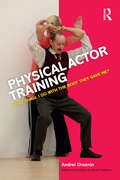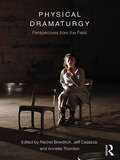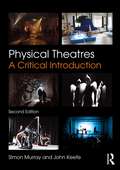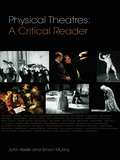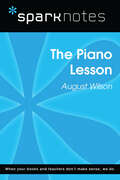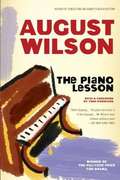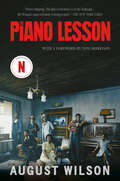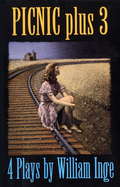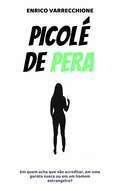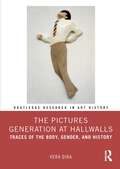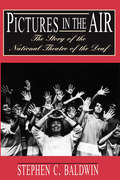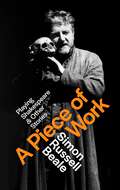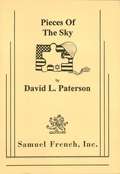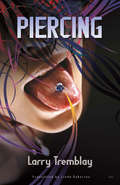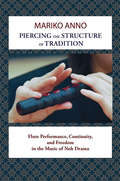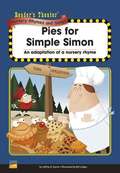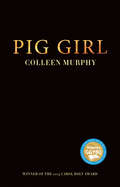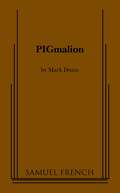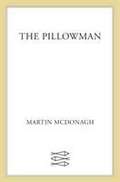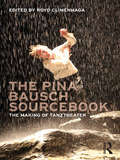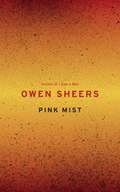- Table View
- List View
Physical Actor Training: What Shall I Do with the Body They Gave Me?
by Andrei DrozninIf, as an actor, your body is your 'instrument' - and the only way you can express the internal impulses of the character you’re playing - what happens when the body-mind, ‘psychophysical’ connection is lost? Andrei Droznin, Russia's foremost teacher of physical actor training, calls this loss the 'desomatization' of the human body, and argues that these connections urgently need to be restored for full expressivity. This is a genuinely unique book which links theory to practice by a man who has worked at the very top of Russian theatre; a movement specialist who has taught at the Moscow Art Theatre as well as drama schools all over the world. Beautifully translated by Natasha Fedorova, this volume will excite and inspire a new generation of English-language readers.
Physical Dramaturgy: Perspectives from the Field
by Rachel Bowditch Jeff Casazza Annette ThorntonWhat is physical dramaturgy? While the traditional dramaturg shares research intellectually, the physical dramaturg does so viscerally and somatically. By combining elements of text, history, dramatic structure, and the author’s intent with movement analysis and physical theatre pedagogies, the physical dramaturg gives actors the opportunity to manifest their work in a connected and intuitive manner and creates a field that is as varied and rich as the theatre itself. Physical Dramaturgy: Perspectives from the Field explores the ways in which this unique role can benefit the production team during the design and rehearsal phases of both traditional and devised productions. Individual chapters look at new ways of approaching a wealth of physical worlds, from the works of Shakespeare and other period playwrights to the processes of Jerzy Grotowski, Lloyd Williamson, Richard Schechner, and Michael Chekhov, and devising original works in a variety of contexts from Pig Iron, Dell’Arte International, Bill Bowers and mime, Tectonic Theater Project, and Liz Lerman’s Dance Exchange. This anthology gives dramaturgs, actors, and directors new ways of looking at existing methods and provides examples of how to translate, combine, and adapt them into new explorations for training, rehearsal, or research.
Physical Theatres: A Critical Introduction
by Simon Murray John KeefeThis new edition of Physical Theatres: A Critical Introduction continues to provide an unparalleled overview of non-text-based theatre, from experimental dance to traditional mime. It synthesizes the history, theory and practice of physical theatres for students and performers in what is both a core area of study and a dynamic and innovative aspect of theatrical practice. This comprehensive book: traces the roots of physical performance in classical and popular theatrical traditions looks at the Dance Theatre of DV8, Pina Bausch, Liz Aggiss and Jérôme Bel examines the contemporary practice of companies such as Théatre du Soleil, Complicite and Goat Island focuses on principles and practices in actor training, with reference to figures such as Jacques Lecoq, Lev Dodin, Philippe Gaulier, Monika Pagneux, Etienne Decroux, Anne Bogart and Joan Littlewood. Extensive cross references ensure that Physical Theatres: A Critical Introduction can be used as a standalone text or together with its companion volume, Physical Theatres: A Critical Reader, to provide an invaluable introduction to the physical in theatre and performance. New to this edition: a chapter on The Body and Technology, exploring the impact of digital technologies on the portrayal, perception and reading of the theatre body, spanning from onstage technology to virtual realities and motion capture; additional profiles of Jerzy Grotowski, Wrights and Sites, Punchdrunk and Mike Pearson; focus on circus and aerial performance, new training practices, immersive and site-specific theatres, and the latest developments in neuroscience, especially as these impact on the place and role of the spectator.
Physical Theatres: A Critical Reader
by Simon Murray John KeefePhysical Theatres: A Critical Reader is an invaluable resource for students of physically orientated theatre and performance. This book aims to trace the roots and development of physicality in theatre by combining practical experience of the field with a strong historical and theoretical underpinning. In exploring the histories, cross-overs and intersections of physical theatres, this critical Reader provides: six new, specially commissioned essays, covering each of the book’s main themes, from technical traditions to contemporary practises discussion of issues such as the foregrounding of the body, training and performance processes, and the origins of theatre in both play and human cognition a focus on the relationship and tensions between the verbal and the physical in theatre contributions from Augusto Boal, Stephen Berkoff, Étienne Decroux, Bertolt Brecht, David George, J-J. Rousseau, Ana Sanchez Colberg, Michael Chekhov, Jeff Nuttall, Jacques Lecoq, Yoshi Oida, Mike Pearson, and Aristotle.
The Piano Lesson (SparkNotes Literature Guide Series)
by SparkNotesThe Piano Lesson (SparkNotes Literature Guide) by August Wilson Making the reading experience fun! Created by Harvard students for students everywhere, SparkNotes is a new breed of study guide: smarter, better, faster. Geared to what today's students need to know, SparkNotes provides: *Chapter-by-chapter analysis *Explanations of key themes, motifs, and symbols *A review quiz and essay topicsLively and accessible, these guides are perfect for late-night studying and writing papers
The Piano Lesson
by August WilsonAugust Wilson has already given the American theater such spell-binding plays about the black experience in 20th-century America as Ma Rainey's Black Bottom, Joe Turner's Come and Gone, and the Pulitzer Prize-winning Fences. In his second Pulitzer Prize-winner, The Piano Lesson, Wilson has fashioned perhaps his most haunting and dramatic work. <p><p> At the heart of the play stands the ornately carved upright piano which, as the Charles family's prized, hard-won possession, has been gathering dust in the parlor of Berniece Charles's Pittsburgh home. When Boy Willie, Berniece's exuberant brother, bursts into her life with his dream of buying the same Mississippi land that his family had worked as slaves, he plans to sell their antique piano for the hard cash he needs to stake his future. But Berniece refuses to sell, clinging to the piano as a reminder of the history that is their family legacy. This dilemma is the real "piano lesson," reminding us that blacks are often deprived both of the symbols of their past and of opportunity in the present.
The Piano Lesson (Drama, Plume Ser.)
by August WilsonWinner of the Pulitzer Prize for Drama and winner of the New York Drama Critics Circle Award for Best Play, this modern American classic is about family, and the legacy of slavery in America. August Wilson has already given the American theater such spell-binding plays about the black experience in 20th-century America as Ma Rainey's Black Bottom, Joe Turner's Come and Gone, and the Pulitzer Prize-winning Fences. In his second Pulitzer Prize-winner, The Piano Lesson, Wilson has fashioned perhaps his most haunting and dramatic work. At the heart of the play stands the ornately carved upright piano which, as the Charles family's prized, hard-won possession, has been gathering dust in the parlor of Berniece Charles's Pittsburgh home. When Boy Willie, Berniece's exuberant brother, bursts into her life with his dream of buying the same Mississippi land that his family had worked as slaves, he plans to sell their antique piano for the hard cash he needs to stake his future. But Berniece refuses to sell, clinging to the piano as a reminder of the history that is their family legacy. This dilemma is the real "piano lesson," reminding us that blacks are often deprived both of the symbols of their past and of opportunity in the present.
Picnic
by William IngeThis title collects four plays by American playwright William Inge, including Come Back Little Sheba, Picnic, Bus Stop, and The Dark at the Top of the Stairs.
Picolé de pera
by Enrico VarrecchioneO tão aguardado início no programa de estudos Erasmus, na Suécia, logo se revela um encontro desagradável com um universo no qual violência, sexualidade e abuso se sobrepõem. O protagonista, e também autor, narra os primeiros doze dias de estada no país escandinavo, entre a pequena cidade de Uddevalla e a grande e cosmopolita Gotemburgo, a difícil convivência com sua coinquilina, Lena, e um sentimento de inadequação que, mais tarde, culminará em uma crise pessoal e psicológica.
The Pictures Generation at Hallwalls: Traces of the Body, Gender, and History (Routledge Research in Art History)
by Vera DikaIn this book, Vera Dika rewrites the story of the Pictures Generation from the perspective of the Hallwalls Contemporary Arts Center in Buffalo, NY. Her work is based on interviews with living artists, archival research, and personal collections, including films, videotapes, and sound recordings. At once aesthetic, cultural, and political, this renewed perspective asks new questions and rewrites past assumptions about the artists’ work. The legendary members of the East Coast Pictures Generation emerged at Hallwalls Contemporary Art Center in Buffalo in the mid-1970s. These young people had started Hallwalls, an artist-run organization that invited artists from a variety of mediums to show their work. It also featured productions by the founding members themselves: Robert Longo, Charles Clough, Cindy Sherman, Nancy Dwyer, and Michael Zwack. The works discussed in the volume include performance, video, films, painting, music, and literature, and have been chosen because of the way they foreground states of the body in relationship to conditions of their medium. As a distinguishing feature of Hallwalls artists’ work, the practice uses these traces to make metaphors on the process of mechanical reproduction itself. The Hallwalls artists’ work also gives testament to Buffalo and to New York City, the cities that formed their historical contexts. This book will be of interest to scholars working in art history, performance studies, film studies, and gender studies.
Pictures in the Air: The Story of the National Theatre of the Deaf
by Stephen C. BaldwinNow available in paperback; ISBN 1-56368-140-4
A Piece of Work: Playing Shakespeare and Other Stories
by Simon Russell BealeSimon Russell Beale is one of Britain's most recognisable and well-loved actors. He has played many roles on stage, film, television and radio - ranging from Winston Churchill to Stalin, George Smiley to King Arthur. But ever since his appearance at school as a glamorous Desdemona, complete with false eyelashes that rendered him half-blind, he has been captivated by Shakespeare. In A Piece of Work, Russell Beale tries to get under the skin of the playwright and find out what interested him. Was Shakespeare an instinctive 'conservative' or, rather, gently subversive? How collaborative was he? Did he add a line to Hamlet in order to accommodate his ageing and increasingly chubby principal actor, Richard Burbage? Did he suffer from insomnia and experience sexual jealousy? Russell Beale describes what it is to approach and live with some of Shakespeare's most famous characters. Some of the actor's inspiration comes from surprising sources. Watching Coronation Street gave him an idea for how Richard III might react on hearing of the death of the two Princes in the Tower; a visit to elderly patients in a local hospital gave him insights into King Lear's descent into madness; and the memory of childhood family holidays led him to a spectacular plunge into an ornamental pool in Much Ado About Nothing.Funny and touching about his family, Russell Beale also writes fascinatingly about some of the supremely creative people he counts as his friends - including Sam Mendes, Nick Hytner, Stephen Sondheim and Lauren Bacall. A Piece of Work is a brilliant account of an actor's life and work - and his relationship with our foremost dramatist.
A Piece of Work: Playing Shakespeare and Other Stories
by Simon Russell BealeSimon Russell Beale is one of Britain's most recognisable and well-loved actors. He has played many roles on stage, film, television and radio - ranging from Winston Churchill to Stalin, George Smiley to King Arthur. But ever since his appearance at school as a glamorous Desdemona, complete with false eyelashes that rendered him half-blind, he has been captivated by Shakespeare. In A Piece of Work, Russell Beale tries to get under the skin of the playwright and find out what interested him. Was Shakespeare an instinctive 'conservative' or, rather, gently subversive? How collaborative was he? Did he add a line to Hamlet in order to accommodate his ageing and increasingly chubby principal actor, Richard Burbage? Did he suffer from insomnia and experience sexual jealousy? Russell Beale describes what it is to approach and live with some of Shakespeare's most famous characters. Some of the actor's inspiration comes from surprising sources. Watching Coronation Street gave him an idea for how Richard III might react on hearing of the death of the two Princes in the Tower; a visit to elderly patients in a local hospital gave him insights into King Lear's descent into madness; and the memory of childhood family holidays led him to a spectacular plunge into an ornamental pool in Much Ado About Nothing.Funny and touching about his family, Russell Beale also writes fascinatingly about some of the supremely creative people he counts as his friends - including Sam Mendes, Nick Hytner, Stephen Sondheim and Lauren Bacall. A Piece of Work is a brilliant account of an actor's life and work - and his relationship with our foremost dramatist.
Pieces of the Sky
by David PatersonDrama / 4m, 1f / Interior / This drama by the author of The Great Gilly Hopkins and Finger Painting in a Murphy Bed focuses on a strange, intense friendship that develops during World War II in Nebraska. Sarah is an independent and determined middle aged mother who runs a diner in Deliverance and worries about her son, a soldier fighting in Europe. She becomes the Jewish mailman's only friend in town, partly because she feels that a good relationship with the man who brings notices of war deaths will somehow shield her son from harm. Sarah and Joshua put together complex jigsaw puzzles to pass the time, until Sarah thinks he has betrayed her.
Piercing
by Linda Gaboriau Larry TremblayThree tales spin a web of suspense, impending violence and tragedy that haunt the sleek façade of a city.
Piercing the Structure of Tradition: Flute Performance, Continuity, and Freedom in the Music of Noh Drama
by Mariko AnnoWhat does freedom sound like in the context of traditional Japanese theater? Where is the space for innovation, and where can this kind of innovation be located in the rigid instrumentation of the Noh drama? In Piercing the Structure of Tradition, Mariko Anno investigates flute performance as a space to explore the relationship between tradition and innovation. This first English-language monograph traces the characteristics of the Noh flute (nohkan), its music, and transmission methods and considers the instrument's potential for development in the modern world. Anno examines the musical structure and nohkan melodic patterns of five traditional Noh plays and assesses the degree to which Issō School nohkan players maintain to this day the continuity of their musical traditions in three contemporary Noh plays influenced by Yeats. Her ethnographic approach draws on interviews with performers and case studies, as well as her personal reflection as a nohkan performer and disciple under the tutelage of Noh masters. She argues that traditions of musical style and usage remain influential in shaping contemporary Noh composition and performance practice, and the existing freedom within fixed patterns can be understood through a firm foundation in Noh tradition.
Pies for Simple Simon: An Adaptation of a Nursery Rhyme
by Jeffrey B. Fuerst Bill Ledger Carrie SmithNIMAC-sourced textbook
Pig Girl
by Colleen MurphyAt 4:00 a.m. on a secluded farm, a woman fights to take her life back from a serial killer as her desperate sister and a haunted police officer reach across time and distance in an attempt to rescue her.
PIGmalion
by Mark DunnDramatic Comedy / 9m, 8f (cross casting and double casting possible) Inspired by Pygmalion, Shaw's classic drawing room tale of language and class division, and its musical incarnation, My Fair Lady, the play tells the story of one Eliza Doolittle-the daughter of a hardscrabble Mississippi pig farmer-who sells homemade pork rinds at the Tri-Counties Fair and Livestock Show, and dreams of someday working as a waitress at "one of those nice downtown barbecue restaurants where all the tourists go." With the support of her best friend, a sassy Transgender firecracker named Miss Tiffany Box, patroness Ida Hill and her daughter Clara; and with Ida's instantly enamored son Freddy nipping romantically at Eliza's heels, Delta-drawlin' Eliza engages the services of a "Kudzu-league" college prof named Henry Higgins to take the country out of her speech and give her some semblance of class. Devotees of Shaw's original will delight in the transplantation of Eliza and Professor Higgins and his colleague Pickering to the American South. But this gentle, warm-hearted comedy gives us something else as well, a question for which everyone in the play must find the answer: how do we reconcile the way we present ourselves on the outside with who we truly are on the inside?
The Pilgrim's Progress
by John BunyanThis book, the most perfect allegory ever produced, has been more widely read in English than any other book except the Bible. The English of the book is pure and strong; but its great power lies neither in its English nor in the perfection of the allegory, but in the fact that in picturing his own religious struggles, Bunyan pictured those of other men as well. Stylistically, Bunyan combines simplicity with rare earnestness. He had something to say, and in his in most soul he felt that this something was of supreme importance for all time. He also had a rare combination of imagination and dramatic power. His abstractions became living persons. It would be difficult to find English prose that is more simple, earnest, strong, imaginative, and dramatic than this work. Bunyan's style felt the shaping influence of the Bible more than of all other works combined. He knew the Scriptures almost by heart. It is no wonder that in the allegories of the world's literature, The Pilgrim's Progress stands out as a masterpiece written to people of every age and condition.
The Pillowman: A Play
by Martin McDonaghWhile still in his twenties, the Anglo-Irish playwright Martin McDonagh has filled houses in New York and London, been showered with the theatre world's most prestigious accolades, and electrified audiences with his cunningly crafted and outrageous tragicomedies. With echoes of Stoppard and Kafka, his latest drama, The Pillowman, is the viciously funny and seriously disturbing tale of a writer in an unnamed totalitarian state who is interrogated about the gruesome content of his short stories and their similarities to a number of child-murders occurring in his town.
The Pina Bausch Sourcebook: The Making of Tanztheater
by Royd ClimenhagaPina Bausch’s work has had tremendous impact across the spectrum of late twentieth-century performance practice, helping to redefine the possibilities of what both dance and theater can be. This edited collection presents a compendium of source material and contextual essays that examine Pina Bausch's history, practice and legacy, and the development of Tanztheater as a new form, with sections including: Dance and theatre roots and connections; Bausch’s developmental process; The creation of Tanztheater; Bausch’s reception; Critical perspectives. Interviews, reviews and major essays chart the evolution of Bausch’s pioneering approach and explore this evocative new mode of performance. Edited by noted Bausch scholar, Royd Climenhaga, The Pina Bausch Sourcebook aims to open up Bausch’s performative world for students, scholars, dance and theatre artists and audiences everywhere.
Pink Mist
by Owen SheersFrom the author of I Saw a Man comes a powerful drama in verse that captures both the trauma of modern warfare and the difficulty of transitioning back to normal life after combat. In early 2008, three young friends from Bristol decide to join the army and are deployed to the conflict in Afghanistan. Within a short space of time the three men return to the women in their lives—a wife, a mother, a girlfriend—all of whom must now share the psychological and physical aftershocks of military service. Written from the points of view of each soldier, Sheers explores not only their experiences in the field of battle, but also the grueling process of recovery following a debilitating injury, the strain of PTSD on a new marriage, and the emotional toll of survivor's guilt among soldiers and their loved ones at home. Drawing on interviews with soldiers and their families, Pink Mist illuminates the enduring human cost of war and its all too often devastating effect upon the young lives pulled into its orbit. A work of great dramatic power, documentary integrity, and emotional intensity.
